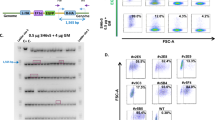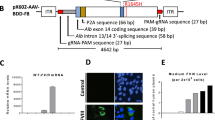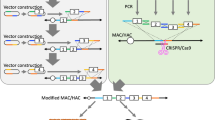Abstract
We earlier reported that, a 16 bp Rep-binding element (RBE) was sufficient for mediating Rep-dependent integration into AAVS1 in vitro. We explored here the potential use of this RBE in site-specific genome integration at the AAVS1 site in vivo using transgenic mice carrying the human AAVS1 locus in their genome. In the presence of a Rep-donor plasmid, an human blood coagulation factor IX (hFIX) expression plasmid (pRBE–CMV–hFIX) containing the 16 bp RBE was delivered to AAVS1 transgenic mice by hydrodynamic injection. Insertion of the transgene into the AAVS1 site of the mouse genome was confirmed by nested PCR at the junction of the plasmid/AAVS1 locus. Sequencing analysis found the site-specific insertion in four of seven animals injected with pRBE–CMV–hFIX but in none of the mice injected with pN2–CMV–hFIX, the control construct without the 16 bp RBE or with pRBE–CMV–hFIX plasmid but without co-expressing Rep. Plasma hFIX levels in pRBE–CMV–hFIX-injected animals were higher and lasted longer than in the pN2–CMV–hFIX control group. The levels of hFIX in pRBE–CMV–hFIX-injected animals were also significantly higher than in the control animals after partial hepatectomy (PH). These results showed that the 16 bp RBE could mediate the delivery of a therapeutic gene into the AAVS1 locus in a Rep-dependent, site-specific manner in vivo, suggesting its potential application in gene therapy.
This is a preview of subscription content, access via your institution
Access options
Subscribe to this journal
Receive 12 print issues and online access
$259.00 per year
only $21.58 per issue
Buy this article
- Purchase on Springer Link
- Instant access to full article PDF
Prices may be subject to local taxes which are calculated during checkout





Similar content being viewed by others
Abbreviations
- AAV:
-
adeno-associated virus
- ITR:
-
inverted terminal repeat
- RBE:
-
Rep-binding element
- hFIX:
-
human blood coagulation factor IX.
References
Kotin RM, Linden RM, Berns KI . Characterization of a preferred site on human chromosome 19q for integration of adeno-associated virus DNA by non-homologous recombination. EMBO J 1992; 11: 5071–5078.
Chiorini JA, Yang L, Safer B, Kotin RM . Determination of adeno-associated virus Rep68 and Rep78 binding sites by random sequence oligonucleotide selection. J Virol 1995; 69: 7334–7338.
Srivastava A, Lusby EW, Berns KI . Nucleotide sequence and organization of the adeno-associated virus 2 genome. J Virol 1983; 45: 555–564.
Linden RM, Winocour E, Berns KI . The recombination signals for adeno-associated virus site-specific integration. Proc Natl Acad Sci USA 1996; 93: 7966–7972.
Linden RM, Ward P, Giraud C, Winocour E, Berns KI . Site-specific integration by adeno-associated virus. Proc Natl Acad Sci USA 1996; 93: 11288–11294.
Young Jr SM, McCarty DM, Degtyareva N, Samulski RJ . Roles of adeno-associated virus Rep protein and human chromosome 19 in site-specific recombination. J Virol 2000; 74: 3953–3966.
Murphy M, Gomos-Klein J, Stankic M, Falck-Pedersen E . Adeno-associated virus type 2 p5 promoter: a rep-regulated DNA switch element functioning in transcription, replication, and site-specific integration. J Virol 2007; 81: 3721–3730.
Philpott NJ, Gomos J, Berns KI, Falck-Pedersen E . A p5 integration efficiency element mediates Rep-dependent integration into AAVS1 at chromosome 19. Proc Natl Acad Sci USA 2002; 99: 12381–12385.
Feng D, Chen J, Yue Y, Zhu H, Xue J, Jia WW . A 16bp Rep binding element is sufficient for mediating Rep-dependent integration into AAVS1. J Mol Biol 2006; 358: 38–45.
Bakowska JC, Di Maria MV, Camp SM, Wang Y, Allen PD, Breakefield XO . Targeted transgene integration into transgenic mouse fibroblasts carrying the full-length human AAVS1 locus mediated by HSV/AAV rep(+) hybrid amplicon vector. Gene Therapy 2003; 10: 1691–1702.
Song S, Lu Y, Choi YK, Han Y, Tang Q, Zhao G et al. DNA-dependent PK inhibits adeno-associated virus DNA integration. Proc Natl Acad Sci USA 2004; 101: 2112–2116.
Nakai H, Yant SR, Storm TA, Fuess S, Meuse L, Kay MA . Extrachromosomal recombinant adeno-associated virus vector genomes are primarily responsible for stable liver transduction in vivo. J Virol 2001; 75: 6969–6976.
Urabe M, Kogure K, Kume A, Sato Y, Tobita K, Ozawa K . Positive and negative effects of adeno-associated virus Rep on AAVS1-targeted integration. J Gen Virol 2003; 84: 2127–2132.
Miller DG, Rutledge EA, Russell DW . Chromosomal effects of adeno-associated virus vector integration. Nat Genet 2002; 30: 147–148.
Liu F, Song Y, Liu D . Hydrodynamics-based transfection in animals by systemic administration of plasmid DNA. Gene Therapy 1999; 6: 1258–1266.
Weitzman MD, Kyostio SR, Kotin RM, Owens RA . Adeno-associated virus (AAV) Rep proteins mediate complex formation between AAV DNA and its integration site in human DNA. Proc Natl Acad Sci USA 1994; 91: 5808–5812.
Kearns WG, Afione SA, Fulmer SB, Pang MC, Erikson D, Egan M et al. Recombinant adeno-associated virus (AAV-CFTR) vectors do not integrate in a site-specific fashion in an immortalized epithelial cell line. Gene Therapy 1996; 3: 748–755.
Samulski RJ, Zhu X, Xiao X, Brook JD, Housman DE, Epstein N et al. Targeted integration of adeno-associated virus (AAV) into human chromosome 19. EMBO J 1991; 10: 3941–3950.
Ponnazhagan S, Erikson D, Kearns WG, Zhou SZ, Nahreini P, Wang XS et al. Lack of site-specific integration of the recombinant adeno-associated virus 2 genomes in human cells. Hum Gene Therapy 1997; 8: 275–284.
Rizzuto G, Gorgoni B, Cappelletti M, Lazzaro D, Gloaguen I, Poli V et al. Development of animal models for adeno-associated virus site-specific integration. J Virol 1999; 73: 2517–2526.
Recchia A, Perani L, Sartori D, Olgiati C, Mavilio F . Site-specific integration of functional transgenes into the human genome by adeno/AAV hybrid vectors. Mol Ther 2004; 10: 660–670.
Cortes ML, Oehmig A, Saydam O, Sanford JD, Perry KF, Fraefel C et al. Targeted integration of functional human ATM cDNA into genome mediated by HSV/AAV hybrid amplicon vector. Mol Ther 2008; 16: 81–88.
Yant SR, Meuse L, Chiu W, Ivics Z, Izsvak Z, Kay MA . Somatic integration and long-term transgene expression in normal and haemophilic mice using a DNA transposon system. Nat Genet 2000; 25: 35–41.
Gui T, Lin HF, Jin DY, Hoffman M, Straight DL, Roberts HR et al. Circulating and binding characteristics of wild-type factor IX and certain Gla domain mutants in vivo. Blood 2002; 100: 153–158.
Miao CH, Thompson AR, Loeb K, Ye X . Long-term and therapeutic-level hepatic gene expression of human factor IX after naked plasmid transfer in vivo. Mol Ther 2001; 3: 947–957.
Acknowledgements
The authors acknowledge the support of the State Hightech Development Program (863-2006AA02Z161; 2007AA021002) and the National Basic Research Program (973.2004CB518803) of China.
Author information
Authors and Affiliations
Corresponding authors
Rights and permissions
About this article
Cite this article
Xu, Z., Chen, J., Yue, Y. et al. A 16-bp RBE element mediated Rep-dependent site-specific integration in AAVS1 transgenic mice for expression of hFIX. Gene Ther 16, 589–595 (2009). https://doi.org/10.1038/gt.2009.9
Received:
Revised:
Accepted:
Published:
Issue Date:
DOI: https://doi.org/10.1038/gt.2009.9
Keywords
This article is cited by
-
Recent Advances in CRISPR/Cas9 Delivery Approaches for Therapeutic Gene Editing of Stem Cells
Stem Cell Reviews and Reports (2023)
-
Reply to “Wild-type AAV Insertions in Hepatocellular Carcinoma Do Not Inform Debate Over Genotoxicity Risk of Vectorized AAV”
Molecular Therapy (2016)
-
Gene therapy for hemophilia B mice with scAAV8-LP1-hFIX
Frontiers of Medicine (2016)



